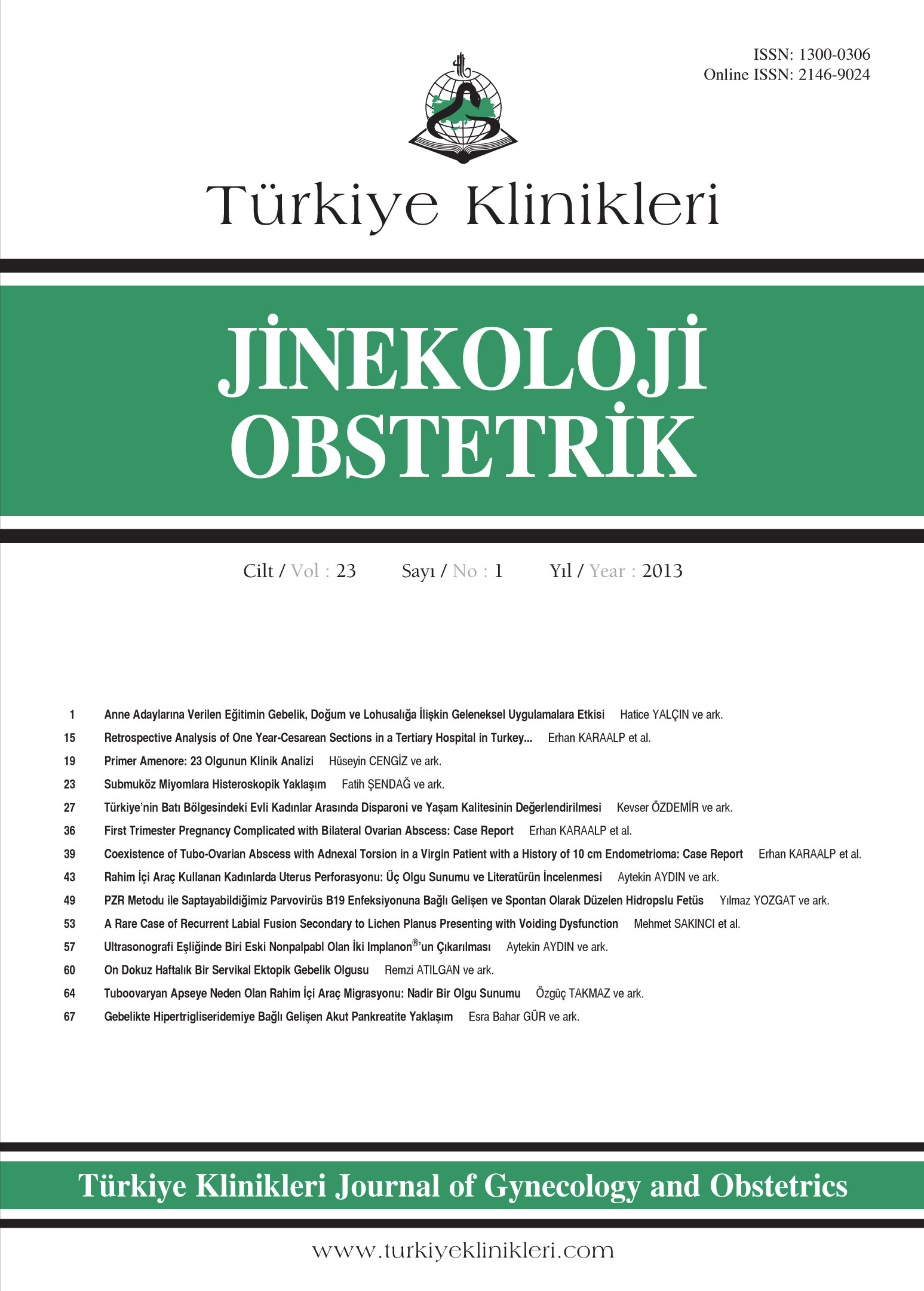Open Access
Peer Reviewed
CASE REPORTS
3245 Viewed1318 Downloaded
Migration of an Intrauterine Device Leading to Formation of Tuboovarian Abscess: A Rare Case Report
Tuboovaryan Apseye Neden Olan Rahim İçi Araç Migrasyonu: Nadir Bir Olgu Sunumu
Turkiye Klinikleri J Gynecol Obst. 2013;23(1):64-6
Article Language: TR
Copyright Ⓒ 2025 by Türkiye Klinikleri. This is an open access article under the CC BY-NC-ND license (http://creativecommons.org/licenses/by-nc-nd/4.0/)
ÖZET
Rahim içi araç (RİA) transpozisyonu nadir görülen bir durumdur. Takılma sırasında uterin perforasyonu takiben veya tubal ostiumlardan migrasyon ile hidrosalpenks, pelvik apse, intestinal obstrüksiyon, peritonite sebep olabilmektedir. Laktasyon dönemindeki kadınlar uterin perforasyona bağlı RİA transpozisyonu açısından özellikle risk altındadır. Bu olgu sunumumuzda, tuboovaryan apseye sebep olan bir RİA dislokasyonu olgusunu sunmaktayız. Eksplorasyonda tubaya yapışık yaklaşık 4x3 cm'lik apse ile uyumlu kitle izlendi. Apse lojunda bakırlı RİA saptandı. Hastaya sol salpanjektomi ve apse lojunun eksizyonu yapıldı. Postoperatif takiplerinde hastaya ikili (gentamisin 160 mg/gün+klindamisin 2700 mg/gün) antibiyoterapi başlandı ve 5 gün bu tedavi rejimi devam edildi. Bu olgularda ultrasonografi ve X-ray grafi temel değerlendirme yöntemleri olmasına rağmen anamnez en önemli yönlendirici basamaktır. Önceki kontrasepsiyon yöntemlerinin net sorgulanması, hastanın ifade etmediği kayıp RİA olduğunu anlamada esastır.
Rahim içi araç (RİA) transpozisyonu nadir görülen bir durumdur. Takılma sırasında uterin perforasyonu takiben veya tubal ostiumlardan migrasyon ile hidrosalpenks, pelvik apse, intestinal obstrüksiyon, peritonite sebep olabilmektedir. Laktasyon dönemindeki kadınlar uterin perforasyona bağlı RİA transpozisyonu açısından özellikle risk altındadır. Bu olgu sunumumuzda, tuboovaryan apseye sebep olan bir RİA dislokasyonu olgusunu sunmaktayız. Eksplorasyonda tubaya yapışık yaklaşık 4x3 cm'lik apse ile uyumlu kitle izlendi. Apse lojunda bakırlı RİA saptandı. Hastaya sol salpanjektomi ve apse lojunun eksizyonu yapıldı. Postoperatif takiplerinde hastaya ikili (gentamisin 160 mg/gün+klindamisin 2700 mg/gün) antibiyoterapi başlandı ve 5 gün bu tedavi rejimi devam edildi. Bu olgularda ultrasonografi ve X-ray grafi temel değerlendirme yöntemleri olmasına rağmen anamnez en önemli yönlendirici basamaktır. Önceki kontrasepsiyon yöntemlerinin net sorgulanması, hastanın ifade etmediği kayıp RİA olduğunu anlamada esastır.
ANAHTAR KELİMELER: Rahim içi araç yer değişimi; tıbbi hikâye alımı
ABSTRACT
Dislocation of intrauterin device (IUD) is rarely seen. It may cause hydrosalpinx, pelvic abcess, intestinal obstruction, peritonitis after placement of the IUD via uterin perforation or expulsion through tubal ostium. In this case report, we are presenting a tuboovarian abscess caused by IUD dislocation. Approximately 4x3 cm abscess adherent to left tuba was seen on exploration. Copper IUD was determined in abscess. Left salpingectomy and abscess excision were performed. Combination of 2 antibiotics (gentamycine 160 mg/day+clindamycin 2700 mg/day) was started postoperatively, and continued for five days. Although in such cases, the basic evaluation methods are ultrasonography and direct radiography, medical history is the most important clue for the diagnosis. Asking for the contraceptive method in use is very crucial for recognizing a dislocated IUD.
Dislocation of intrauterin device (IUD) is rarely seen. It may cause hydrosalpinx, pelvic abcess, intestinal obstruction, peritonitis after placement of the IUD via uterin perforation or expulsion through tubal ostium. In this case report, we are presenting a tuboovarian abscess caused by IUD dislocation. Approximately 4x3 cm abscess adherent to left tuba was seen on exploration. Copper IUD was determined in abscess. Left salpingectomy and abscess excision were performed. Combination of 2 antibiotics (gentamycine 160 mg/day+clindamycin 2700 mg/day) was started postoperatively, and continued for five days. Although in such cases, the basic evaluation methods are ultrasonography and direct radiography, medical history is the most important clue for the diagnosis. Asking for the contraceptive method in use is very crucial for recognizing a dislocated IUD.
MENU
POPULAR ARTICLES
MOST DOWNLOADED ARTICLES





This journal is licensed under a Creative Commons Attribution-NonCommercial-NoDerivatives 4.0 International License.










